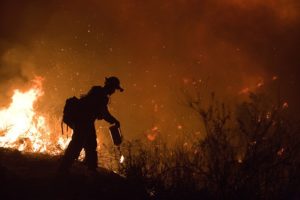News and Commentary. In the category of “this shouldn’t need to be said,” we’ll say it – drone operators should stay away from the California wildfires if they aren’t part of the emergency response.
The FAA has issued temporary flight restrictions (TFRs) over the fires, and warns that violators may be fined up to $20,000. Western region FAA representative Ian Gregor issued a press release this weekend asking operators not to interfere. The TFRs are a “prohibition on all aircraft, including manned aircraft and drones, that are not involved in the firefighting efforts.”
“…Any drone pilot who recklessly interferes with firefighting or other emergency response operations can face civil penalties (fines) from the FAA of up to $20,000 per violation,” said Gregor.
It’s been a terrible year for natural disasters around the world and also in the U.S., from a devastating hurricane season to wildfires in California that have burned hundreds of miles. But amidst the destruction, there’s been a glimmer of a silver lining for the drone industry. Drones have been able to take the opportunity of showing what they can do, providing relief for communities across the country. Drones have been used for flood and damage assessment, to speed insurance claims, identify stranded victims, help responders allocate resources, and in some cases provide planning assistance to guard against future events. In fact, at a drone conference speech immediately after the Houston flooding, FAA Administrator Michael Huerta called the use of drones in disaster relief “a turning point” for the industry.
While drones have proven their worth as a tool, rogue operators cause legitimate problems, says Rob Schield, founder and CEO of drone and equipment provider Fire Cam and a veteran firefighter. “Drones can be a major solution for Police and Fire Departments. However, when a large wildfire incident happens, airtankers have a hard time making fire retardant drops below 400′ if consumer drones are violating TFRs or other regulations,” says Schield. “Unfortunately, consumers are flying above 400′ AGL all the time and the FAA is not playing around anymore…If someone brings down a manned aircraft, they face the possibility of a long sentence or even life in prison if someone dies.”
“Drones have their specific uses in Public Safety such as search and rescue, suspect recovery and many others,” says Schield. “However, they should never interfere with firefighting suppression operations.”
In the last week, drones have hit the headlines several times. Wired magazine published a piece about the LAFD using their drones for the first time in the Skirball fire to help identify hotspots, track the path of the fire, and monitor damage. The conversation is finally turning for the drone industry. Communities can now see the benefits that drones provide, not only the problems that rogue drones cause. It’s up to all drone operators to use good judgement to ensure that the trend continues.
Miriam McNabb is the Editor-in-Chief of DRONELIFE and CEO of JobForDrones, a professional drone services marketplace, and a fascinated observer of the emerging drone industry and the regulatory environment for drones. Miriam has penned over 3,000 articles focused on the commercial drone space and is an international speaker and recognized figure in the industry. Miriam has a degree from the University of Chicago and over 20 years of experience in high tech sales and marketing for new technologies.
For drone industry consulting or writing, Email Miriam.
TWITTER:@spaldingbarker
Subscribe to DroneLife here.
